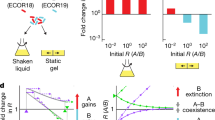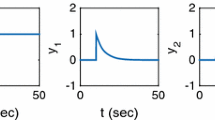Abstract
Although there is a long history of conjecture regarding the role and significance of bacterial chemotaxis in microbial ecology, only recently has a significant body of work appeared attempting to address this issue. The purpose of this paper is to provide a concise overview of this work, which combined mathematical modeling of bacterial population migration and experimental measurement of the model parameters with modeling of competitive microbial population dynamics in a nonmixed environment. Predictions from the population dynamics models, based on experimental estimates of the various motility and growth parameter values, are related to the small number of experimental observations available to date dealing with the effects of bacterial motility on competition in a nonmixed environment. Current results indicate that cell motility and chemotaxis properties can be as important to population dynamics as cell growth kinetic properties, so that greater attention to this aspect of microbial behavior is warranted in future studies of microbial ecology.
Similar content being viewed by others
References
Adler J (1973) A method for measuring chemotaxis and use of the method to determine optimum conditions for chemotaxis byEscherichia coli. J Gen Microbiol 74:77–91
Adler J (1975) Chemotaxis in bacteria. Ann Rev Biochem 44:341–356
Berg HC (1988) A physicist looks at bacterial chemotaxis. Cold Spring Harbor Symp Quant Biol 53:1–9
Berg HC, Brown DA (1972) Chemotaxis inEscherichia coli analysed by three-dimensional tracking. Nature 239:500–504
Berg HC, Purcell EM (1977) Physics of chemoreception. Biophys J 20:193–219
Block SM, Segall JE, Berg HC (1983) Adaptation kinetics in bacterial chemotaxis. J Bacteriol 154:312–323
Borkovich KA, Simon MI (1990) The dynamics of protein phosphorylation in bacterial chemotaxis. Cell 63:1339
Boyce JR, Miller RV (1982) Motility as a selective force in the reversion of cystic fibrosis-associated mucoidPseudomonas aeruginosa to the nonmucoid phenotype in culture. Infect Immun 37:840–844
Brown DA, Berg HC (1974) Temporal stimulation of chemotaxis inEscherichia coli. Proc Natl Acad Sci USA 71:1388–1392
Ford RM, Phillips BR, Quinn JA, Lauffenburger D (1991) Stopped-flow chamber and image analysis sytem for quantitative characterization of bacterial population migration: Motility and chemotaxis ofEscherichia coli K12 to fucose. Microb Ecol 22:127–138
Freter R, O'Brien PCM, Halstead SA (1978) Adhesion and chemotaxis as determinants of bacterial association with mucosal surfaces. Adv Exp Med Biol 107:429–437
Holz M, Chen S (1979) Spatio-temporal structure of migrating chemotactic band ofEscherichia coli. I. Traveling band profile. Biophys J 26:243–262
Keller EFF, Segel LA (1971) Model for chemotaxis. J Theor Biol 30:225–234
Kelly FX, Dapsis K, Lauffenburger D (1988) Effects of bacterial chemotaxis on dynamics of microbial competition. Microb Ecol 16:115–131
Kelman A, Hruschka J (1973) The role of motility and aerotaxis in the selective increase of avirulent bacteria in still broth cultures ofPseudomonas solanacearum. J Gen Microbiol 76:177–188
Kennedy MJ, Lawless JG (1985) Role of chemotaxis in the ecology of dentrifiers. Appl Environ Microbiol 49:109–114
Koshland DE Jr (1980) Bacterial chemotaxis as a model behavioral system. Distinguished lecture series of the Society of General Physiologists, vol. 2, Raven Press, New York
Lauffenburger D, Aris R, Keller KH (1981) Effects of random motility on growth of bacterial populations. Microb Ecol 7:207–227
Lauffenburger D, Aris R, Keller KH (1982) Effects of cell motility and chemotaxis on microbial population growth. Biophys J 40:209–219
Lauffenburger D, Calcagno B (1983) Competition between two microbial populations in a non-mixed environment: Effect of cell random motility. Biotech Bioeng 25:2103–2125
Lauffenburger D, Kennedy CR, Aris R (1984) Traveling bands of chemotactic bacteria in the context of population growth. Bull Math Biol 46:19–40
Lauffenburger DA, Rivero M, Kelly F, Ford R, DiRienzo J (1987) Bacterial chemotaxis: Cell flux model, parameter measurement, population dynamics, and genetic manipulation. Ann NY Acad Sci 506:281–295
Macnab RM (1980) Sensing the environment: Bacterial chemotaxis. In: Goldberger R (ed) Biological regulation and development, vol. 2. Plenum Press, New York, pp. 337–412
Macnab RM (1987) Motility and chemotaxis. In: Neidhardt FC (ed)Escherichia coli andSalmonella typhimurium: Cellular and molecular biology. American Society for Microbiology, Washington, DC, pp 732–759
Mcnab RM, Koshland DE Jr (1972) The gradient-sensing mechanism in bacterial chemotaxis. Proc Natl Acad Sci USA 69:2509–2512
Old DC, Duguid JP (1970) Selective outgrowth of fimbriate bacteria in static liquid medium. J Bacteriol 103:447–456
Ordal GW (1985) Bacterial chemotaxis: Biochemistry of behavior in a single cell. Crit Rev Microbiol 12:95–130
Parkinson JS (1988) Protein phosphorylation in bacterial chemotaxis. Cell 53:1–2
Pilgrim WR, Williams FD (1976) Survival value of chemotaxis in mixed cultures. Can J Microbiol 22:1771–1773
Rivero M, Lauffenburger D (1986) Quantification of bacterial chemotaxis by measurement of model parameters using the capillary assay. Biotechnol Bioeng 28:1178–1190
Rivero M, Tranquillo R, Buettner H, Lauffenburger D (1989) Transport models for chemotactic cell populations based on individual cell behavior. Chem Eng Sci 44:2881–2897
Segel LA (1977) A theoretical study of receptor mechanisms in bacterial chemotaxis. Siam J Appl Math 32:653–665
Segel LA, Jackson J (1973) Theoretical analysis of chemotactic movement in bacteria. J Mech Cell Motility 2:25–34
Smith JL, Doetsch RN (1969) Studies on negative chemotaxis and the survival value of motility inPseudomonas fluorescens. J Gen Microbiol 55:379–391
Spudich J, Koshland DE Jr (1975) Quantitation of the sensory response in bacterial chemotaxis. Proc Natl Acad Sci USA 72:710–713
Staffeld PO, Quinn JA, Lauffenburger D (1988) Analysis of cell transport phenomena: Bacterial chemotaxis in the capillary assay. Chem Eng Comm 58:339–351
Stock J, Stock AM (1987) What is the role of receptor methylation in bacterial chemotaxis? Trends Biochem Sci 12:371–375
Vicker MG (1981) Ideal and non-ideal concentration gradient propagation in chemotaxis studies. Exp Cell Res 136:91–100
Author information
Authors and Affiliations
Rights and permissions
About this article
Cite this article
Lauffenburger, D.A. Quantitative studies of bacterial chemotaxis and microbial population dynamics. Microb Ecol 22, 175–185 (1991). https://doi.org/10.1007/BF02540222
Issue Date:
DOI: https://doi.org/10.1007/BF02540222




